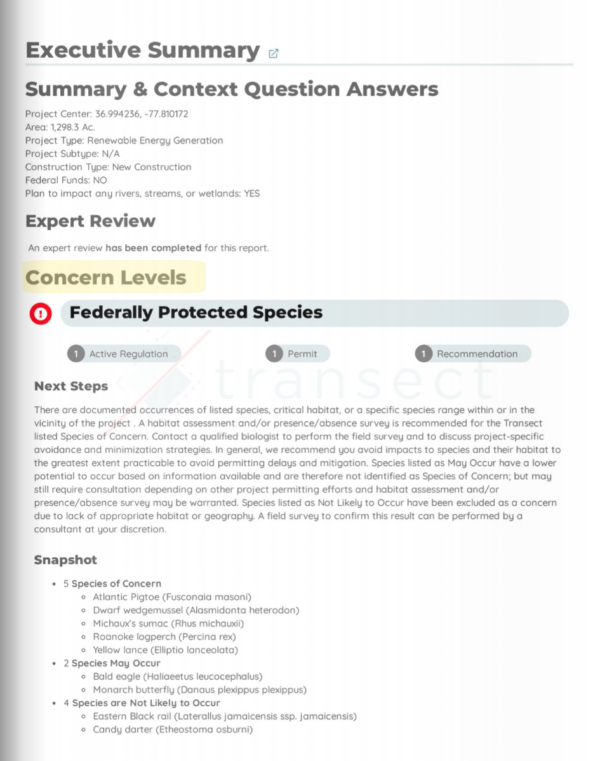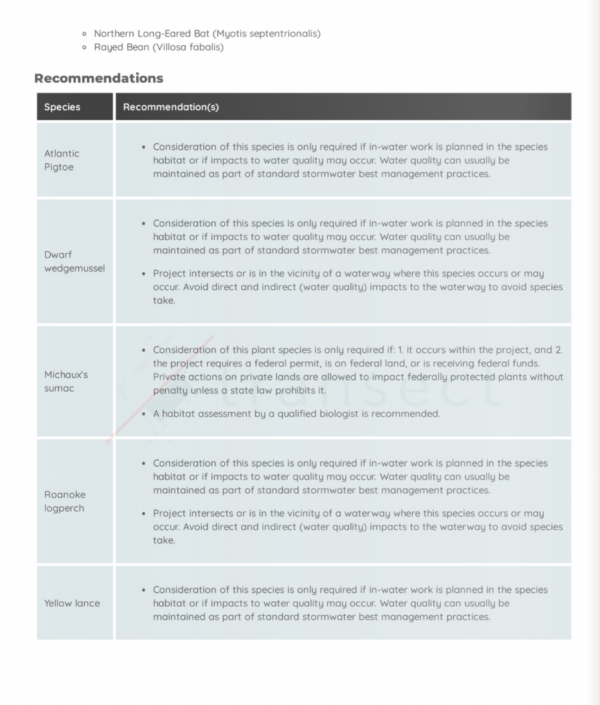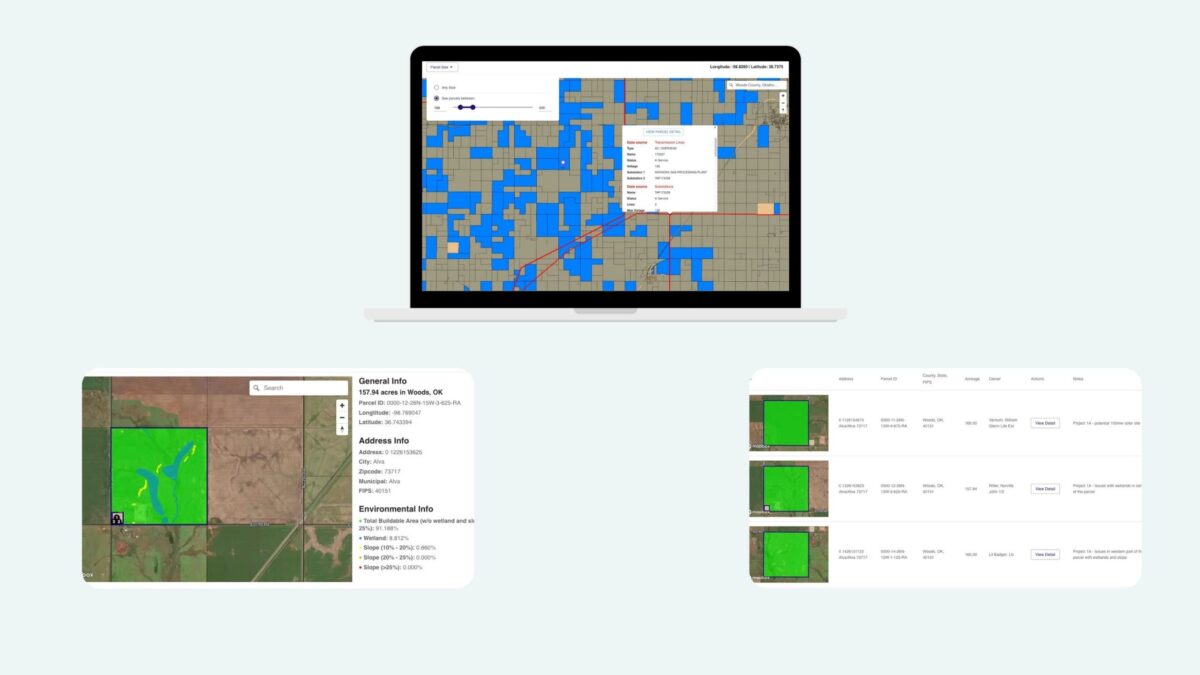pv magazine USA examines technology companies providing software solutions to accelerate and assist the development of distributed generation projects such as community solar and energy storage systems, as well as improve grid transmission reliability and distribution solutions.
Permitting & due diligence
With an environmental consulting background, “hiking boots and field work” were the nature of the beast for Robin Laine coming out of college at the University of Texas, Austin, examining the environmental impact of power plants in various use cases and local environments, she says.
Over years of research and trekking around performing environmental studies, Laine said “permitting for project development was a very manual, old school process that hasn’t changed much since the Seventies [while] environmental policy framework” hasn’t changed much at all since then.
Laine, who co-founded permitting and due diligence software platform Transect with husband Sam Laine in 2017, told pv magazine USA that the manual process of permitting a solar project traditionally spanned over several months out of a process that would see a project constructed over a few years. Drawing from cumulative research from her studies, now the permitting of a solar project can be done in a matter of minutes using the Transect platform.
Following the 2014 acquisition by Apex Companies of Southwest Geoscience, where Laine directed its natural resources business, Laine identified numerous inefficiencies for a scalable project development cycle early in the process, pointing to overlap between environmental research and administrative paperwork usually performed by attorneys.
Using environmental data and advances in artificial intelligence, Transect’s automated project permitting system helps developers and utility stakeholders alike find the right site locations for construction of solar projects and perform various due diligence processes.
Transect’s platform incorporates a four-part process:
- Critical issues analysis: Desktop fieldwork report of everything that could go wrong in project development stages.
- ‘What-If’ Scenarios: This layer factors in sloping and shade factors, wildlife, wetlands and flood plain concerns as well as housing development colocation.
- PermitSection (PS): legacy methodology enabled by Google cloud-sharing for project development teams to share information.
- Site selection: a directory to statewide resources for developers for filing purposes across the independent system operator regional broadly.

Transect, Inc.

Transect’s permitting system is industry agnostic at its core, though Laine said right now it’s seen the most inbound interest for renewable energy project development. Other markets it can serve include commercial real estate and government solutions.
Customers include “Con Edison all the way down to two or three-man development outfits with a truck,” Laine said about Transect’s customer universe. According to its website, users include OYA Renewables, DSD Renewables, Origis Energy and Recurrent Energy, among others. The company provides its solutions under an annual software-as-a-service (SaaS) business model using a seat-based licensing agreement providing customers unlimited access to Transect’s reports, she added.
Over its five years in business, Transect is now used by developers across all 50 U.S. states, she said, and the company has funded its business plan with a $7.6 million Series A round from April 2022 via Bentley iTwin Ventures, and before that with $2.6 million of early stage growth capital.
At year end 2022, San Antonio, Texas-based Transect had 30 employees and could look to get to 50 to 60 employees in the next couple of years, with a more Series B funding round likely during 2024, she added.
The passing of the Inflation Reduction Act in August 2022 created a “land race” for community solar and various other DG projects, Laine said, whose development can be accelerated using the Transect platform.
The energy communities piece of the IRA, where new DG projects are deployed in regions with decommissioning baseload power assets such as coal, provide a good use case for Transect’s system in brownfield developments where installations can receive an additional 10% federal credit in addition to the 30% solar ITC and 30% standalone storage credit, among other credits.
“What’s important right now is the way environmental permitting right now is not scalabale at all, [as] the typing up reports as a consultant is really inefficient,” Laine said. “Now we have IRA goals of developing renewables on a land size the equivalent of South Dakota.”
Project siting
Brooklyn, N.Y.-based Paces AI launched its geographic information system (GIS)-based project siting software product in August 2022, unintentionally at the same time the landmark Inflation Reduction Act was signed into law.
Founder and chief executive officer James McWalter tells pv magazine USA that the mapping and siting system provides parcel-specific project siting data in real-time to customers, to show the most ideal location for installing utility-scale and community solar projects. Another portion of Paces customers are transmission utility and grid system operator professionals.
Project development is growing quickly but 80% of U.S. renewable projects fail because they are built in the wrong places, costing $17 billion per year in project siting costs, he said. Paces AI provides siting locations to customers in just a few minutes based on an accumulation of state, regional and interstate power and utility data.
A North Carolina utility solar developer recently found a prospective development site within 3 hours of using Paces Search, saving the developer “thousands of dollars” in consulting work as would have been previously necessary for project siting, McWalter said.
Paces found and combined over 2,000 acres of land with the same landowner for the development of the N.C. utility solar project siting, McWalter said, giving the customer site control on two sites in one-third the time it would have taken using the traditional consultancy route.
The N.C. solar developer has additional active projects and landowner engagement campaigns in Illinois for community solar, he said. With the new IRA Energy Communities definitions, the customer wanted to know which would be eligible for the extra tax credit.
Paces AI’s dashboard now includes search functions covering the various sub-sections of IRA adders, the solar ITC and standalone storage credit, enabling customers to find project sites that stand to see the highest rate of federal incentives over the coming years, McWalter said.
“From site control to notice to proceed (NTP), we allow users to use a single repository of information, handling all the factors data for a project’s success,” said McWalter. Paces can provide customers the top three factors that could impede or hold back the project based on risk factors.
Paces sources data from GIS parcel search engines as well as independent system operator and regional transmission operator databases, while the company also provides source details to all of the data it provides to customers.
McWalter co-founded Paces AI in January 2022 with Charles Bai, a former Facebook AI engineer, after a 15-year career in data science and analytics roles working at FactSet, Respondent and Hello Vera.
Paces has raised $2.8 million from a February 2022 seed funding from Resolute Ventures, Y Combinator, Climate Capital, and UpHonest Capital, among others. The company has about six full-time employees and will look to hire more full-time data and software engineers following another funding round later this year, he said.
Additional assets such as energy storage systems and EV charging infrastructure are also able to be recommended using the Paces platform, McWalter said.
Like Transect, Paces AI also provides a software-as-a-service access to customers using a subscription model.
This content is protected by copyright and may not be reused. If you want to cooperate with us and would like to reuse some of our content, please contact: editors@pv-magazine.com.









By submitting this form you agree to pv magazine using your data for the purposes of publishing your comment.
Your personal data will only be disclosed or otherwise transmitted to third parties for the purposes of spam filtering or if this is necessary for technical maintenance of the website. Any other transfer to third parties will not take place unless this is justified on the basis of applicable data protection regulations or if pv magazine is legally obliged to do so.
You may revoke this consent at any time with effect for the future, in which case your personal data will be deleted immediately. Otherwise, your data will be deleted if pv magazine has processed your request or the purpose of data storage is fulfilled.
Further information on data privacy can be found in our Data Protection Policy.